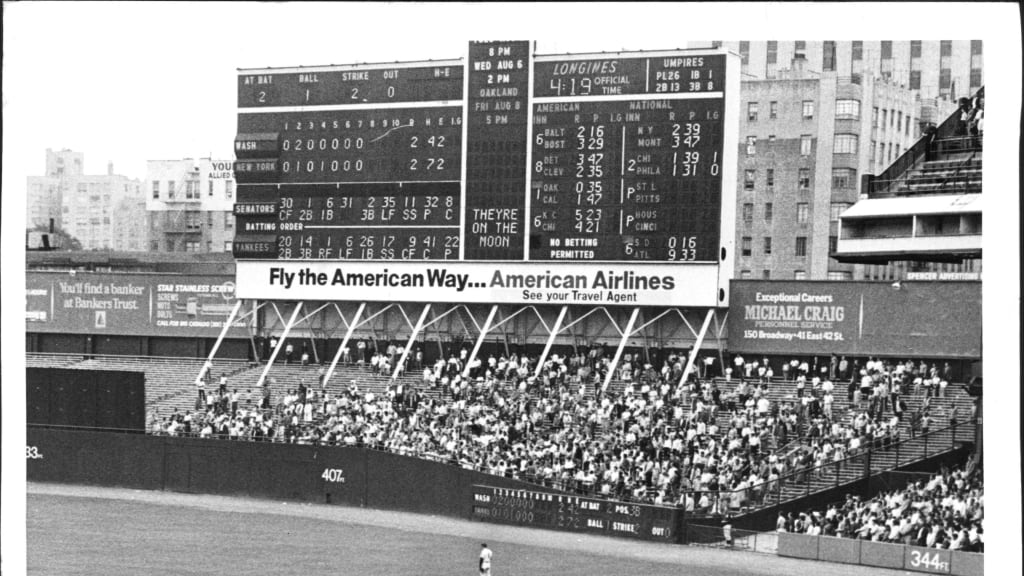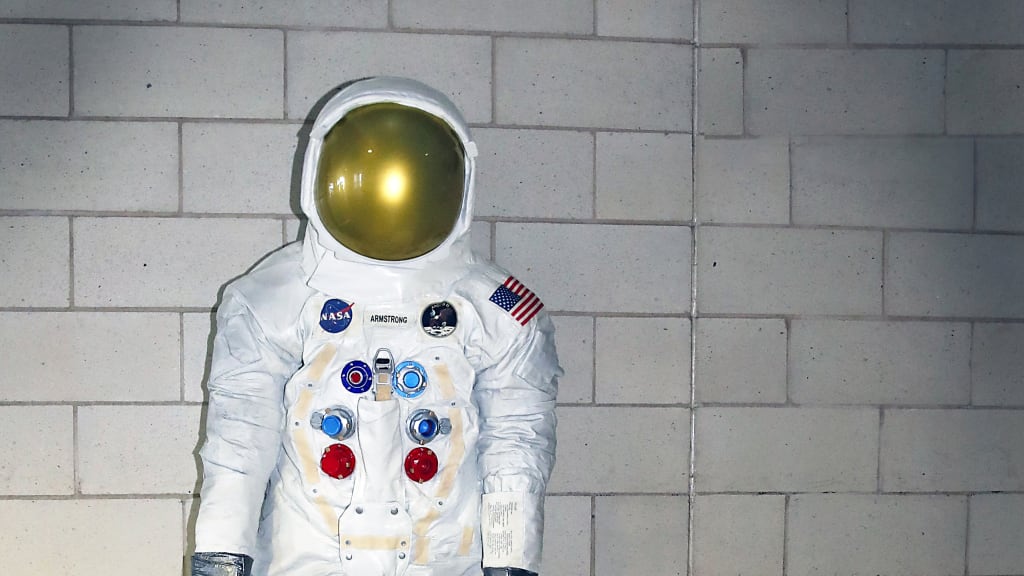
In 1969, the Yankees retired Mickey Mantle’s No. 7, Thurman Munson made his big league debut, and Mel Stottlemyre won 20 games for the third and final time in his career. But with the team finishing fifth in the newly formed American League East division and missing the postseason for a fifth straight year, there wasn’t the same swell of unforgettable games and moments that other Yankees seasons had produced.
One game that season lives on in the annals of history, though -- and not just baseball history. The Yankees’ 3-2 win over the Washington Senators on July 20 provided a truly unique experience. While Gene Michael’s walk-off single in the 11th frame sent fans home happy, it was a moment a few innings earlier, one that had little to do with baseball, that embedded itself in the memory banks of the 34,000 in attendance that day.
With the score tied, 2-2, in the top of the eighth, Washington third baseman Ken McMullen was batting with runners on the corners and nobody out. Hoping to uneven things against Yankees reliever Jack Aker, McMullen found himself in a 1-2 hole when public-address announcer Bob Sheppard’s voice began to boom throughout Yankee Stadium. It was 4:18 p.m. in the Bronx. A minute earlier, some 244,390 miles away, the Eagle had landed.
“Ladies and gentlemen, your attention please,” Sheppard said as the umpires brought the game to a halt. “You will be happy to know that the Apollo 11 has landed safely on the moon.”
The legendary announcer’s reveal resulted in about 45 seconds of deafening, uninterrupted cheering. Fans roared as “THEYRE ON THE MOON” appeared on the scoreboard in center field. “It was something to hear them scream,” Michael said after the game. Children, many of them in the house for that afternoon’s Bat Day promotion, waved their prized possessions in the air in frenzied celebration.
Sheppard then pierced through the noise as he led fans in a moment of silent prayer, one asking that the astronauts return safely to Earth. “I was really impressed by how quiet they were when we had the minute of silence,” Yankees manager Ralph Houk told reporters. “You didn’t hear a sound.” The Mormon Tabernacle Choir’s recording of “America the Beautiful” followed, to which the crowd, knowing the United States had scored a major victory in the space race against its Cold War rivals, sang along.
“My recollection is that everybody just went crazy, and the world stopped,” said Mark Polansky, then a 13-year-old Yankees fan sitting behind home plate in the Stadium’s mezzanine that day. “What I remember was the community atmosphere. You’re over there at the ballpark and you’re there to watch a sporting event and to root on your heroes, and yet, when that happened, it wasn’t a baseball game anymore. You go ahead and high-five complete strangers. Everybody in that Stadium was amazed. We were all equals at that point. … All Americans were in amazement at what had been achieved by our country and the astronauts.”
And then, with one small step for man and one giant leap for mankind celebrated in the familiar enclave of America’s pastime, the game resumed at 4:21 p.m. Aker got McMullen to hit a bouncer to third, and Bobby Cox fired it home, where catcher Jake Gibbs tagged Mike Epstein for the first out of the eighth.
***
Fifty years later, man’s first trip to the moon still inspires awe. Fascination with space did not begin with Neil Armstrong’s and Buzz Aldrin’s first lunar steps, but their journey certainly served as a springboard for humanity’s enthrallment with the world that lies beyond our planet. From moviegoers to science fair entrants to present-day explorers, people of all ages and backgrounds continue to be captivated by the great unknown.
And so, baseball will give fans an opportunity to explore their curiosity at the ballpark this summer and celebrate Apollo 11’s semicentennial. In honor of the mission, the Smithsonian’s National Air and Space Museum launched Apollo at the Park, a program bringing full-sized replicas of Armstrong’s Apollo 11 spacesuit to 15 stadiums nationwide.
“Baseball ballparks are the perfect venues for new generations to learn more about that summer night, July 20, 1969,” museum director Ellen Stofan said in a statement, “and they allow us to celebrate Apollo’s 50th across the country.”
Fittingly, the first replica spacesuit debuted in the nation’s capital when Nationals Park unveiled its statue on June 4. The other 14 suits were not far behind; on June 18, the Yankees installed theirs on the Main Level concourse near the New York Yankees Museum. As for the remaining stadiums, Atlanta’s SunTrust Park, Boston’s Fenway Park, Chicago’s Wrigley Field, Cincinnati’s Great American Ball Park, Cleveland’s Progressive Field, Colorado’s Coors Field, Detroit’s Comerica Park, Houston’s Minute Maid Park, Minnesota’s Target Field, Pittsburgh’s PNC Park, San Francisco’s Oracle Park, Seattle’s T-Mobile Park and Tampa Bay’s Tropicana Field are all participating.
The spacesuits will provide baseball fans with more than just a photo op. Rather, the suits will be interactive, allowing fans to scan different parts, such as the NASA logo, with their smartphones in order to access videos and information about the Apollo 11 mission.
The Yankees will officially recognize the Apollo 11 anniversary with a ceremony on July 20 before their game against the Rockies. Deborah A. Tymon, the Yankees’ senior vice president of marketing, hopes it will be a day fans of all ages appreciate.
“Stadiums bring together multiple generations of fans, and I think we have a generation who remembers the start of the space program and man landing on the moon. Then you have a generation that’s being told the story of space,” Tymon said. “Because of the multigenerational fan base, the fact that they link world events to their baseball moments in history and the fact that we draw enormous crowds on a daily basis, to tie the sport and history together to view the spacesuit -- it’s perfect placement.”
***

It may seem like an unusual pairing at first, baseball and space. But the scene on July 20, 1969, when the news broke of the Apollo Lunar Module Eagle touching down in the Sea of Tranquility, was not unique to The House That Ruth Built. All across the country, scores of Americans learned of the mission’s success while munching on peanuts and Cracker Jack. For many, it was unforgettable. For some, such as Polansky, the 13-year-old fan in attendance, it was inspirational.
Years after learning of Apollo 11’s success at Yankee Stadium, Polansky enrolled at Purdue University, the alma mater of Armstrong, the first man on the moon, and Gene Cernan, the last man on the moon. Riveted by space from an early age -- and further inspired by that afternoon in the Bronx -- Polansky began to pursue his own interstellar career after meeting Cernan during his freshman year. Polansky ultimately became an aerospace engineer, a fighter pilot in the United States Air Force and a NASA astronaut. The New Jersey native flew on three space shuttle missions that all contributed to the assembly of the International Space Station. By the time his flying career ended, Polansky had logged nearly 1,000 hours in space.
Looking back at July 20, 1969, he remembers realizing then, even at such a young age, that “going to the moon was so much bigger than that game.” That was true then, and it remains true today as the Apollo 11 mission turns 50 years old.
Polansky gets giddy when talking about all the possibilities that the solar system still has to offer. He’s glad that people remain charmed by space, that humans continue to explore. When told of Apollo at the Park, he can’t help but hope that the replica Armstrong suits capture the imagination of young baseball fans the way the real First Man once captured his.
“As I look at it today, what I think is really awesome is that not only is exploration still something that inspires us, but we’re also looking at a lot of the real benefits,” Polansky said. “We don’t go into space just to go. We do it because we think there are some real tangible returns that can improve life on the planet for a lot of people. Hopefully, the stuff that we do inspires a lot of kids to get into technical fields because these are the folks that are going to go ahead and invent new technologies and take care of us when we all get old.”